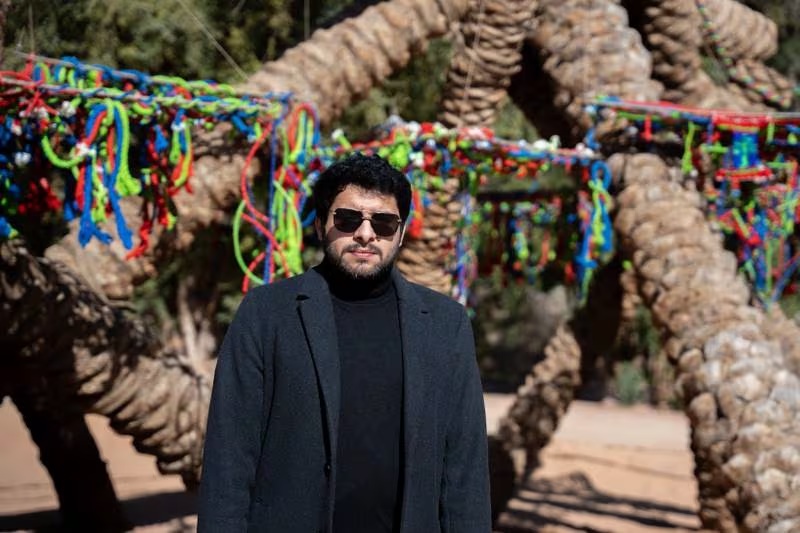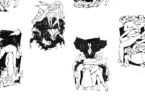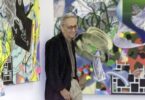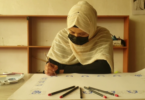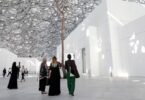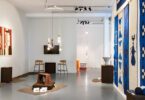Razmig Bedirian
Within the AlUla Oasis, a lush expanse of 2.3 million date palms, Obaid Alsafi’s installation stands as a call to protect the natural environment.
His work, entitled Palms in Eternal Embrace, has been named winner of the sixth Ithra Art Prize. The $100,000 award is the largest art grant of its kind in the region.
This is the first year that the King Abdulaziz Centre for World Culture (Ithra) has collaborated with the Royal Commission for AlUla on the prize.
The winning installation was unveiled to coincide with the opening of AlUla Arts Festival, which runs at venues across the historic city until March 2. When the festival concludes, Palms in Eternal Embrace will become part of Ithra’s permanent collection.
It comprises 30 palm trunks positioned in a toppled arrangement and fastened together by recycled fabrics. In a landscape of towering palm trees, Alsafi’s work strikes a somewhat bittersweet tone. The tumbled arrangement of the palm trunks, all without their fronds, sharply contrast the lushness of the surrounding vegetation. The textiles, with vibrant reds, greens and blues, enliven the installation with colour.
:quality(70)/cloudfront-eu-central-1.images.arcpublishing.com/thenational/PSMLEYA5XJAYBF2DR5CTWM462I.jpg)
“Palm trees are traditionally seen as a symbol of prosperity, and have been a natural resource in the region since the beginning of human settlement,” Alsafi tells the National.
“Through this work I wanted to highlight the importance of preserving our landscapes, cultural and natural heritage. With so many of the world’s palm trees at risk, I wish to encourage viewers to reflect in ways we can protect them.”
Alsafi conceptualised the installation in response to the prize’s theme of Art in the Landscape. It invited artists to propose site-specific works that considered AlUla’s ancient history, natural landscape and heritage.
“The 2.3 million date palms of the AlUla Oasis were a direct inspiration for my work,” Alsafi says. “They are prevalent throughout the natural Arabian Peninsula, a motif of Arab identity and a powerful symbol of a cultural and environmental legacy we should strive to protect.”
Another inspiration for the Saudi artist came from his hometown of Qaryat Al Faw, located 700km southwest of Riyadh. Alsafi sourced the trunks from his grandfather’s farm and devised a structure where the weight of each palm tree supported its adjoining counterpart. “I used ropes to link them, drawing from the traditional artistry of rope making,” he explains.
The textiles came from recycled materials and were locally-sourced. Their incorporation within the sculpture is perhaps meant to evoke the way technology can be utilised to safeguard the natural environment.
:quality(70)/cloudfront-eu-central-1.images.arcpublishing.com/thenational/E4RVDSHQ7REIHOQSICFMSWXRXU.jpg)
In form and structure, Palms in Eternal Embrace also has an aesthetic basis in a specific aspect of Saudi history, namely the mysterious 5,000-year-old Al-Rajajil Columns in the Al Jawf region in northern part of the kingdom. The area is home to about 50 sandstone columns, some of which are as thick as 60cm. They are as enigmatic as Britain’s Stonehenge and were believed to have religious significance, while also being used as an astrological tool, observing stars and the change of seasons.
“I have always been fascinated by the mythologies surrounding the Al-Rajajil stone pillars,” Alsafi says. “These pillars, the first art installation I ever saw, exemplify the intersection of history, nature, art and culture. As an artist, I strive to showcase the interconnectedness of all these things, drawing inspiration from the mystery, culture and landscape of northern Saudi Arabia.”
Launched in 2017, the Ithra Art Prize accepts submissions from artists who are from or work in the Arab world. It allocates up to $400,000 to help bring proposals to fruition, besides awarding the winning artist $100,000.
Palms in Eternal Embrace was deemed the winner this year by a committee that included Farah Abushullaih, head of museum at Ithra; Nora Aldabal, executive director of Arts and creative industries at the Royal Commission for AlUla; Emirati artist Mohamed Ibrahim; Sophie Makariou, scientific director for culture and heritage at Afalula; and Aric Chen, general and artistic director at Het Nieuwe Instituut.
Abushullaih said in a statement that Alsafi’s work was selected for “its cohesive, organic specificity to AlUla’s landscape and its commitment to integrating into this landscape in both form and content.”
“It is such a pleasure to see Alsafi’s Palms in Eternal Embrace come to life as part of the AlUla Arts Festival launch, nestled among the AlUla palms that the work gives voice to. We look forward to seeing this installation provoke thought and discussion throughout its six-week exhibition in AlUla, before proudly welcoming it to our permanent collection at Ithra.”
Aldabal, meanwhile, noted that Alsafi’s installation is “a powerful reminder of the vital role of art in bringing attention to the urgency of safeguarding our natural world.”
“We’re proud to present this new commission, selected as winning artwork of the sixth Ithra Art Prize, as part of the third edition of the AlUla Arts Festival, which endeavours to spotlight AlUla’s pivotal role as a vibrant hub for creative expression and cultural exchange.”

